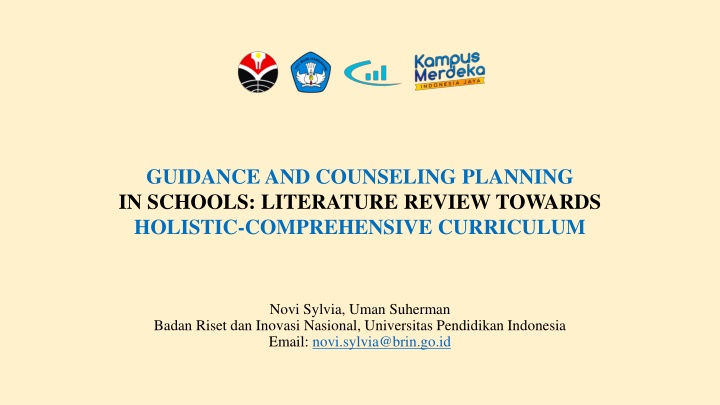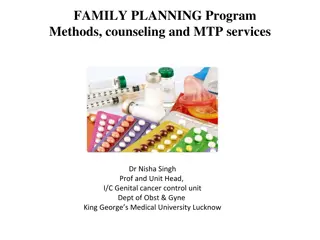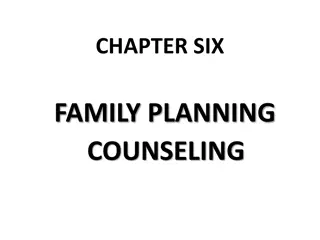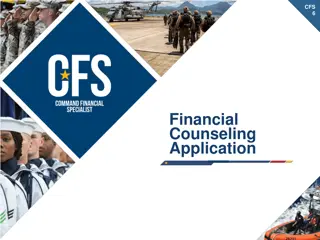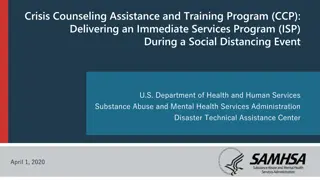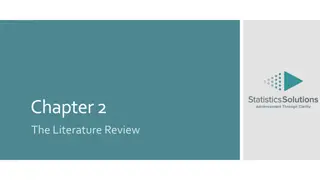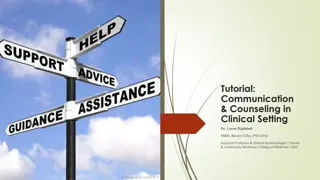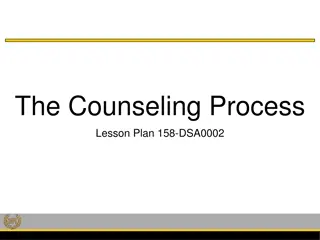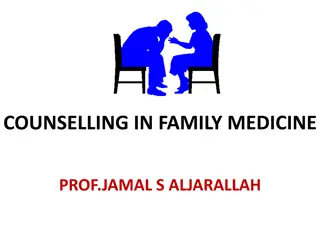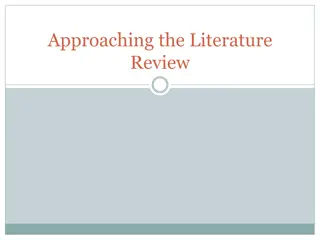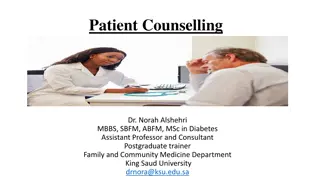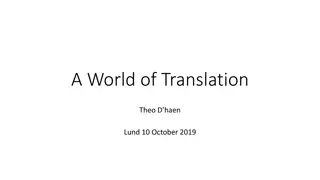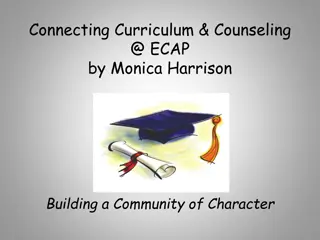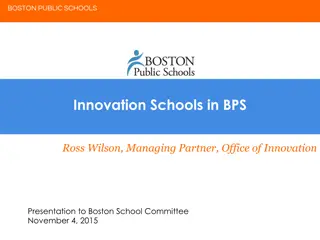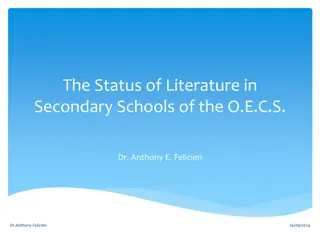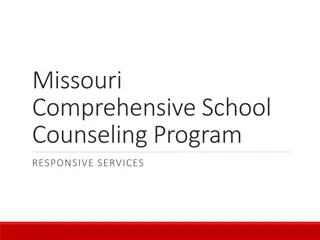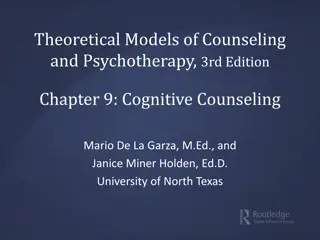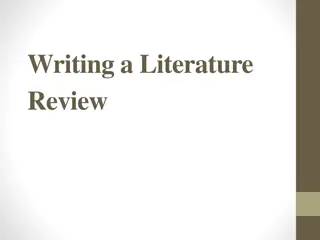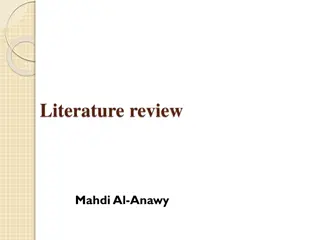Holistic Counseling Planning in Schools: Literature Review for Comprehensive Curriculum
This literature review explores the importance of holistic counseling planning in schools for the development of a comprehensive curriculum. It delves into the significance of human well-being, values, potential, and dignity in education, emphasizing the holistic growth of children through psychological, emotional, moral, spiritual, and physical aspects. The study discusses the role of guidance and counseling in enhancing students' self-awareness, skills, and contributions to society.
Download Presentation

Please find below an Image/Link to download the presentation.
The content on the website is provided AS IS for your information and personal use only. It may not be sold, licensed, or shared on other websites without obtaining consent from the author.If you encounter any issues during the download, it is possible that the publisher has removed the file from their server.
You are allowed to download the files provided on this website for personal or commercial use, subject to the condition that they are used lawfully. All files are the property of their respective owners.
The content on the website is provided AS IS for your information and personal use only. It may not be sold, licensed, or shared on other websites without obtaining consent from the author.
E N D
Presentation Transcript
GUIDANCE AND COUNSELING PLANNING IN SCHOOLS: LITERATURE REVIEW TOWARDS HOLISTIC-COMPREHENSIVE CURRICULUM Novi Sylvia, Uman Suherman Badan Riset dan Inovasi Nasional, Universitas Pendidikan Indonesia Email: novi.sylvia@brin.go.id
Background of The Study The primary goal of a humanistic education is human well-being: the primacy of human values, the development of human potential, and the acknowledgment of human dignity. Purpose/aims/goals Planning aspect Holistic curriculum doesn't just aim to teach academic subjects but also aims to develop a child holistically by fostering their psychological, emotional, moral, spiritual, and physical growth. Management Guidance and planning in schools towards holistic-comprehensive curriculum. Guidance and counseling aims to give individuals a better understanding of the self. It helps students recognize their abilities and turn them into useful skills that can contribute to the welfare of society.
Guidance and Counseling in Holistic Curriculum 1. Statement of Vision School Characteristics 2. Goal setting Comprehensive GC: Potential development Vision, Mission, Goal 3. School data collection 4. Needs analysis Learning Organization 5. Program planning 6. Classroom plans Learning Plan
Planning 1: Vision and goal settings Vision Students know themselves and can transform to adapt to the opportunities and challenges in 21st century. Developing transformative competencies in high school students through Big Five personality guidance. Carrying out Big Five personality guidance for two semesters involving various parties in schools, such as: school administration, subject teachers, and parents. Two guidance cycles starting from orientation, practice, and interspersed with reflection and evaluation. Students aged 16 to 18 years in high school. This guidance will be successful if it is implemented consistently according to planning and balanced with supervision. Goal Policy and strategy Implementation Afiliation Prediction
Planning 2: School Data Collection School profile To interpret the school's vision, mission and values as context directions used in guidance and counseling. Structure and number of people To analyze the governance resources, teachers and students in the school as part of student guidance. Curriculum component To study extracurricular, intra-curricular and co- curricular structures that can be used to design guidance or learning content that will be designed for students. Facilities and infrastructure To be familiar with the existing facilities and infrastructure at school to support guidance and counseling services at school.
Planning 3: Need Analysis Headmaster Administrator Subject teachers Parents 1. What is known about guidance and counseling? 2. What should guidance and counseling be like? 3. What should be the priorities for guidance and counseling? 4. Is the current guidance and counseling appropriate? 5. How can the performance of guidance and counseling be improved? 6. What problems should be of mutual concern? Students 1. Administering the Big Five personality test to all students. 2. Mapping the Big Five personality test results. 3. Mapping of groups, sub-groups and individuals according to the results of mapping and analysis of the availability of required resources. 4. Orientation takes the form of an introduction (socialization) of personality guidance according to the student's characteristics, what the goals and benefits are and how long it will last.
Planning 4: Program Planning January February March April May June Initial assessment Process assessment (on-going) Process assessment (on-going) Process assessment (on-going) Process assessment (on-going) Final assessment Guidance reporting Initial assessment Process assessment (on-going) Process assessment (on-going) Process assessment (on-going) Process assessment (on-going) Final assessment Guidance reporting Orientation Management and guidance in accordance with personality characteristics and training that need to be recorded through a journal. Reflection Evaluation Orientation Management and guidance in accordance with personality characteristics and training that need to be recorded through a journal. July August September October November December Reflection Evaluation
Planning 5: Classroom Plans Group Sub-group Individual Activities Habituation of behavior needed to develop each dimension with material in accordance with the results of the needs analysis (Smillie et al., 2019, Schwaba, 2019, Tackett et al., 2019, Shiner, 2019, Jackson & Hill, 2019) Grouping is according to the results of the student's initial assessment Sub-group selection is based on the results of the student's initial assessment. Individual specialization is based on the results of the student's initial assessment
Limitations (Deshmukh & Naik, 2010) Rigidity Planning creates inelasticity and hinders individual initiative and experimentation. Every planner has his or her own likes, dislikes, preferences, attitudes and interests which are reflected in the planning. Planning is a time consuming process as it involves gathering information, its analysis and interpretation Plans do not always reflect the real situation despite advanced forecasting techniques because the future is unpredictable. Planning can lead to a failure to take timely action and opportunities are lost Planning costs should not exceed the estimated benefits of planning. Misguided planning Time consuming Probability in planning False sense of security Expensive
Conclusion Students personality is a means to plan guidance and counseling in school which is focused on the aspect of individual development. The tool that is resulted by the planning process of the management is represented by set of holistic-comprehensive that consist several stages. Each stage is carried out in an integrated manner in coordination with other parties in the school. Recommendation Research and development studies need to be carried out so that we can get a more measurable picture of the results and can provide useful value for guidance and counseling in schools. Several limitations need to be addressed and be reduced to its minimum.
